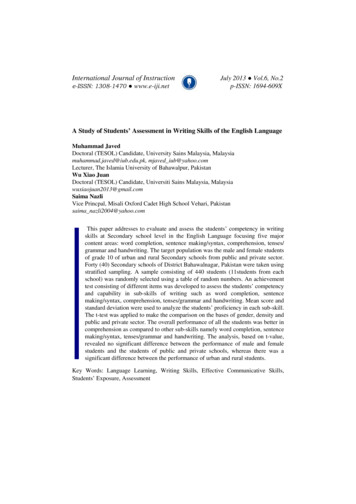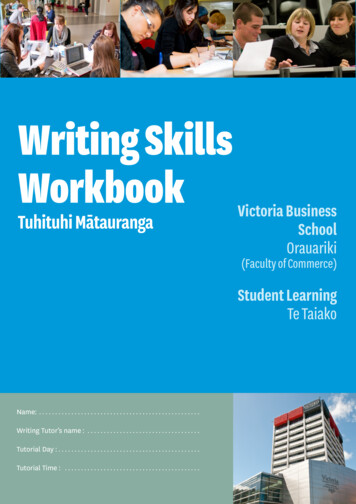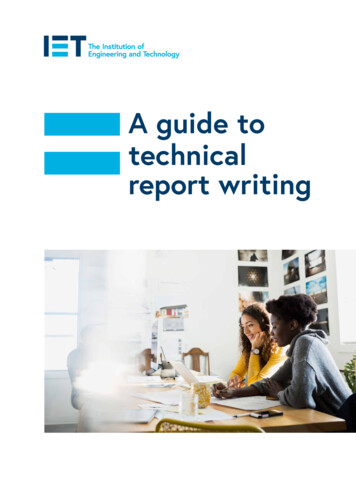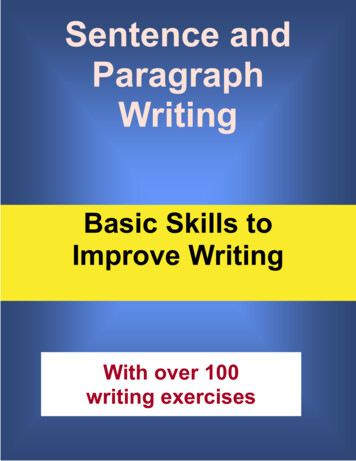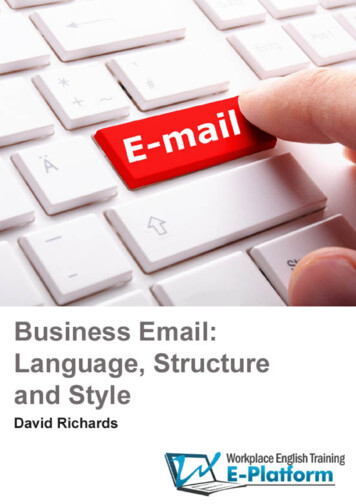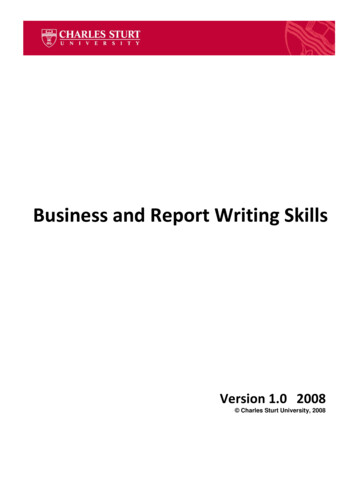
Transcription
Business and Report Writing SkillsVersion 1.0 2008 Charles Sturt University, 2008
Acknowledgement:Workplace Productivity Program (WPP) grant from DEEWR.Organisational Development Resources from Hedy Bryant, Narelle Marr and Judy Doulman.Business and Report Writing programs developed by Stacey Flanagan for CSU in 2007.Special thanks to Royal Melbourne Institute of Technology (RMIT) for permitting use of andreference to online resources.This module will also be available as an online resource on CSU Interact in the later half of2008. Charles Sturt University, 2008Learning resourceBusiness and ReportWriting SkillsOwnerCarissa MichelVersion:1.0September2008Summary/Overview of changesBusiness and Report Writing Skills at CSUVersion 1.0 2008
LEARNING IN THE WORKPLACETo continue to reinforce your learning from this workshop, when you return to your team use the tablebelow to assist you to reflect on the concepts introduced. Your reflection may also incorporate otherbehaviours that you have observed from other leaders within your workplace as well. You should aimto identify at least 10 different situations.Effective business andreport writing conceptsHow have you applied this? Tryto think of a specific worksituationWhat attributes of effectivebusiness and report writing didyou display?What was the outcome?Describe this in terms of thecharacteristics of effectivebusiness and report writing.As part of your reflection, identify some of your key strengths and opportunities for improvement in theway you apply business and report writing skills within the workplace. What steps might yoube able to take to improve your own practice?Business and Report Writing Skills at CSUVersion 1.0 2008
PROGRAM OVERVIEWThis program is designed to introduce some of the key concepts and skills supportingbusiness and report writing at Charles Sturt University (CSU).Although this program does highlight many important areas of business and report writing,further application of the concepts, principles and skills will help to refine and reinforce yourpractice. To this end, you are encouraged to expand your knowledge and skills by takingup work based or other, more formalised learning opportunities at the programs conclusion.Program Objectives:The key objectives of this program are to assist participants:1.)To develop or continue their understanding of Business Writing, Report Writing andBusiness Reporting Language (BRL) at CSU;2.) Familiarisation with CSU Business documents, templates and current workplacepractices at CSU;3.) Identify resources and strategies to help build greater business and report writingability.ICONSThe following icons appear within this learning resource. They highlight important informationas well as activities that can be completed:These are the outcomes that relate to a section of the resource.An Individual or group exercise.A key message or important pointSelf-reflectionThis is a workplace activityBusiness and Report Writing Skills at CSUVersion 1.0 2008
SESSION PLANTime 6-7 hours09.00 – 09.1009:10 – 9.3009.30 – 10.30ActivityIntroduction andObjectives, sessionoutlinePurpose of EffectiveWritingDifferent styles ofcorrespondence andCSU templatesCritical PointsTrainer and Training IntroEmergency Evacuation / housekeepingObjectives of session.Activity (10 min plus discussion) – What your messages reveal aboutyou and your company. Groups discuss, feedback and facilitatorwrites up on butchers paper.In this section we will discuss briefly the memo, email, business letters,business cases, minutes and agendas, as well as media releases.Examples of CSU templates are provided for all when available. LINKto CSU templates. Style ylemanual/appli/letterhead.htmlBusiness p.doc.10.30 – 10.4010.40 – 11.00MORNING TEABREAKWriting for apurpose, gettingstarted, planning.11.00 – 11.30Ensuringprofessionaldocuments.11.30 – 11.40Common BusinessLanguageEffective Emails11.40 – 11.5511.55 – 12.30Reviewing andproofreading CSUstyles and standardsHANDOUT – Key Points to writing a documentExercise – Using the 5W-H Plan for Writing template formulate a planfor a new idea or proposal you have been thinking about discussingwith your area and ask your group to review and give feedback. Keypoints whole group discussion by facilitator/participants.GRAMMAR: Quick grammar exercise (handout)HANDOUT – Some basic Grammatical Ideas (Appendix 4)Writing Powerful and Engaging Sentences. Creating Logic and Flow –Be clear, be concise, be complete, be correct, be concrete, beconvincing, be courteous.Define Common Business Language: Link to language documenton GOVT mework/common-businesslanguage.htmlHANDOUT: Appendix 1 Email Best Practice Guidelines, outlinepoints from presentationLink to Media website resources to help during the editing phaseincluding a glossary of terms and a Quick spelling ure/csuonly/media spelling.htmHANDOUT - Quick tipsLUNCH BREAK12.30 – 1.001.00– 1.30RMIT exercise,Learning skillswebsite.Preview Workplace Activity - RMIT Interactive web /4 WritingSkills/writing tuts/business %20english LL/tips/index.htmlPreview Workplace Learning activity: Student services learningskills website: 1.30 – 2.002.00 – 2.30Report Writing,purpose, planning,structureInitiativesManagementProcess at CSU.Representing DataVisually.Referencing Styles atCSU.Go over structure of reports as per notes and DLS guidelines.Link to Project Status Report Template, other templates on PSCwebsite.Link to Initiatives Management Process at CSU online s/form.htmGo over different examples of visual data, pros and cons . Goover CSU referencing doc Appendix /pdfs/apa2008.pdfBusiness and Report Writing Skills at CSUVersion 1.0 2008
Time 6-7 hours2.30pm – 2.402.40 – 3.00ActivityCommonabbreviations,quotations andadmitting biases,quick tipsAFTERNOON TEABREAKCritical PointsGo over as per manual, quick tips doc page 71Critique your reportGroup Exercise Critique your report:Draft a brief reportGROUP ACTIVITY – Draft a Brief Report Outline and if time thebeginnings of your report : Nominate a scribe to write on butcherspaper. Group discussion to follow.Conclusion, key points from the dayGroup Exercise: What have you learned today that you can takeback to your team and put into practice in your workplace?Further reading and resources. ANY Questions?Complete evaluation forms3.00pm – 3.153.15pm – 3.453.45 – 3.55Summary(Conclusion) andApplication, furtherlearningEvaluation3.55 – 4.00Business and Report Writing Skills at CSUVersion 1.0 2008
INTRODUCTIONPage 7TABLE OF CONTENTSLEARNING IN THE WORKPLACEPROGRAM OVERVIEWICONSSESSION PLAN3445PURPOSE OF EFFECTIVE WRITINGActivity – What your messages reveal about you and your company89DIFFERENT STYLES OF CORRESPONDENCE AND CSU TEMPLATESExercise – Critique and then create a CSU memoExercise – Critique then create a CSU letterWorkplace Learning Activity – Creating a business case made simple10121618WRITING FOR A PURPOSEExercise – How to start: Planning your writing2022ENSURING PROFESSIONAL DOCUMENTSExercise – Quick Grammar Exercise2525COMMON BUSINESS REPORTING LANGUAGE32EFFECTIVE EMAILSExercise – Email Best Practice Guidelines3434REVIEWING AND PROOFREADING: CSU STYLES AND STANDARDSQuick tips to help in editing your writingWorkplace Learning Activity – RMIT Writing tips interactive exercise373840REPORT WRITING: PURPOSE, PLANNING & STRUCTUREWorkplace Learning Activity – Student Services Learning GuidesReading – Division of Library Services Guidelines on Monthly Quarterly and Annual ReportsGroup Exercise – Critique a Report ExampleWorkplace Activity – Initiative Proposal Web Form4343456163REPRESENTING DATA VISUALLYGroup Exercise – Draft an Outline & Monthly Report6469REFERENCING STYLES AT CSU70COMMON ABBRIEVIATIONS71QUOTATIONS72ADMITTING BIASES AND WEAKNESSES OF YOUR REPORT73QUICK TIPS FOR REPORT WRITING74FURTHER TOOLS, TEMPLATES AND RESOURCES76LIST OF APPENDICIS76LIST OF REFERENCES AND FURTHER READING76Business and Report Writing Skills at CSUVersion 1.0 2008
PURPOSE OF EFFECTIVE WRITINGPage 8PART 1: BUSINESS WRITINGPURPOSE OF EFFECTIVE WRITINGWhy write?In business, in the workplace, and in our personal lives, we all stand to benefit from moreeffective communication skills. Writing is essential to communicate your message clearly andprofessionally and to incite action in those who you supervise, work with and require actionfrom.Many in the workforce today struggle with the basics of writing including grammar, spelling andpunctuation and this is what can hold them back and reduce their confidence when it comes tobusiness documents. The style and skills required for formal business writing are bestdeveloped by practice and experience, but with the right tools and know-how it is not hard toimprove.“The objective of communication is not the transmission but the reception.”Source: Dr Gerard M Blair (1991 – 1993)Adjusting writing style to suit topic and reader requirementsYou must adapt the content, tone and language of your documents to the situation (context)and intended audience of your communication.Some business documents and topics require more formal language than others. If unsureseek clarification before starting. For example, documents such as briefing notes, proposals,operational reports and scientific/research reports will require more formal language thanmemos to the social committee or emails to colleagues.Use “you” more than you use “I” or “we”.Use a writing style that is appropriate to the readerWrite from the reader‟s point of view, focus on their needs as well as benefits to them.Example:WRITER’S VIEWPOINTREADER’S VIEWPOINTOur copier makes the best Your copies will be the best you‟ve seen, when youcopies on the market today.use our copier.Consider these factors about your readers before composing your draft:Personality type:detail-orientedTechnical level:expertOperational role:ultimate itiatedgatekeeper.visionary.uninitiated.Based on: Flanagan, S. (2007), Business Writing Skills. For CSU Division of Human Resources Page 9.Business and Report Writing Skills at CSUVersion 1.0 2008
PURPOSE OF EFFECTIVE WRITINGPage 9Activity – What your messages reveal about you and your companyWith business writing, the pressure is on to communicate a clear and concise message withconsideration for the reader in mind.When you are writing a business letter, you want to enhance not only your image but yourcompany‟s image as well. Although it seems unfair, the truth is readers will equate weaknessesin your letters with weaknesses in you, or your company. What impressions do you get frombusiness writing with the following ical and spelling errorsStiff & formal writing styleLots of big, complex wordsVery short, concise sentencesSmudges on paper, tiny margins and weirdspacing between linesSource: Flanagan, S. (2007), Business Writing Skills. For CSU Division of Human Resources Page 7.Business and Report Writing Skills at CSUVersion 1.0 2008
DIFFERENT STYLE OF CORRESPONDENCE & CSUTEMPLATESP a g e 10DIFFERENT STYLES OF CORRESPONDENCE AND CSUTEMPLATESIn this section we will discuss briefly the memo, email (covered in more detail later in themodule), business letters, business cases, minutes and agendas, as well as media releases.Examples of CSU templates are provided for all when available.MEMORANDUM (MEMO)A memorandum (memo) is a piece of correspondence used within an organisation or amongvarious branches or divisions of the same organisation. A memo is usually sent through internalmail or via e-mail.Structure of the MemoOrganisation name, usually contained in the letterhead.Memo or Memorandum at or near the top of the page.Use the reader‟s full name with any professional title such as Dr but without thecomplimentary titles of Mr, Ms or Mrs.To:If you are sending the memo to several people, list them after “To”. If the list is longer than adozen names, place it at the end of the memo and reference it on the “To” line. For example:To: See distribution list on page 6.From:The writer‟s name and professional title go after this heading.Date:Dating a memo gives the organisation a record of its correspondence.Subject:State the topic in a few words but make sure it communicates the point of thememo. E.g. “Changes in Employee Medical Benefits” is more specific than“Employee Benefits Program”.NOTE: The order and placement of these headings may vary from organisation to organisation.The “To” line eliminates the need for a salutation (e.g. ”Dear Mrs. Bernstein”).MessageThe content of the memo should consist of a concise introduction, one or more middleparagraphs conveying the details, and perhaps a brief conclusion. Some memos are as shortas one paragraph, or even one sentence. Memo length is determined by the purpose andaudience.Memos longer than two pages generally have a more formal structure than shorter ones. A longmemo should have the following sections:A summary, placed at the beginning of the memo, should condense the subject to five orten lines. It should not contain jargon or highly technical language.Business and Report Writing Skills at CSUVersion 1.0 2008
DIFFERENT STYLE OF CORRESPONDENCE & CSUTEMPLATESP a g e 11The introduction states the memo‟s purpose and scope. You may add a paragraph or twoof background material if the reader needs more information. The introduction may also beused to ask or answer key questions, thank the reader, or give good news such as theapproval of a proposal. If you must refuse a request or reject an offer, use the introductionto establish your reasons before saying “no”.Discussion. You can use various headings to separate your information into sections: e.g.statement of the problem, approach to the problem, analysis, evaluation, conclusion andrecommendations. The facts of a situation need to be accurately identified and presented,and the arguments need to be reasoned and supported carefully.The conclusion summarises the main points and discusses what action is required of thereaders.The “From” line eliminates the need for a complimentary close (e.g. “Yours faithfully”).Writer’s initials – a memo is completed by the writer‟s initials, not his/her signature,immediately after the last sentence.Distribution list – names on the distribution list are usually typed in alphabetical order.However, if one of the individuals clearly outranks the others, place that name first.Attachments – if you have attachments, you may list them at the top of the memo or at theend.Copies – a duplicate copy of the memo should be held for future reference.Sources:Barrass, R. 2002, Writing at Work: A Guide to Better Writing in Administration, Business and Management, Routledge, London, pp.40-41.Baugh, L.S., Fryar, M. & Thomas, T. 1986, Handbook for Business Writing, National Textbook Company, Lincolnwood, Illinois, pp.119-124.Searles, G.J. 1999, Workplace Communications: The Basics, Allyn & Bacon, Boston, pp. 32-33.What a CSU memo should look likeRead carefully the CSU Style Manual guidelines and view the memo template overleaf whichcan be found anualBusiness and Report Writing Skills at CSUVersion 1.0 2008
DIFFERENT STYLE OF CORRESPONDENCE & CSUTEMPLATESP a g e 12Exercise – Critique and then create a CSU memoUsing the documents you have sourced from your area during the preparationfor this module, critique your example memo with your group. Review andprovide feedback as if you were the writers‟ supervisor. Re-write the memo asyou believe it should be.Business and Report Writing Skills at CSUVersion 1.0 2008
DIFFERENT STYLE OF CORRESPONDENCE & CSUTEMPLATESP a g e 13EMAILSEmails have quickly become the communication mode of choice as it is quick, reliable and youhave the ability to send attachments and/or links to documents.What a CSU Email Should look likeWhen composing an email please carefully consider sensitivity and discretion. CSU Guidelinesfor Email Best Practice are available in the CSU Administration Manual. See Appendix 1.To maintain a minimum standard visual presentation in the use of email for internal and externalUniversity communications, staff are advised to establish official email contact details (alsoknown as an email signature) that are consistent in format, well-presented, easy to read andportray the professionalism appropriate to the University. See excerpt below outlining correctemail signature format from the CSU Style Manual.BackgroundThe standard white background should be used for all emails sent on behalf of the University.Coloured backgrounds, pictures, patterns, decorative motifs such as scrolls or leaves can bedistracting to the reader and may detract from a professional impression.FontAcceptable fonts are Times New Roman (preferred) or Arial in 10, 11 or 12 point. Font shouldbe navy blue or black only.Contact detailsThe contact details on an email amount to sending an electronic University business card.They give an email a professional appearance, and provide appropriate official contactinformation. The standard white background should be used for all emails sent on behalf of theUniversity. Coloured backgrounds, pictures, patterns, decorative motifs such as scrolls orleaves can be distracting to the reader and may detract from a professional impression.Personal statements and messages are discouraged.First name and surnameThese are written in bold in the same font as the email, two points larger. Cursive fonts for thename should be avoided.Job titleThis and all categories that follow are written in the same font as the email, plain text.Division, School, Faculty, Centre or areaCharles Sturt UniversityPostal addressExternal telephone numberExternal fax numberEmail addressCSU web address or URL that directs users to your areaAn example:Joe BloggsEditorDivision of MarketingCharles Sturt UniversityPanorama AvenueBathurst NSW 2795Ph: 02 6338 4411Fax: 02 6338 4378jbloggs@csu.edu.auwww.csu.edu.auBusiness and Report Writing Skills at CSUVersion 1.0 2008
DIFFERENT STYLE OF CORRESPONDENCE & CSUTEMPLATESP a g e 14DisclaimerThe following paragraph should appear at the end of your email signature in standard font, 8point:YOU MUST READ THIS NOTICEThis email has been sent by Charles Sturt University (CSU) (ABN 83 878 708 551, CRICOS00005F). This email (and any attachment) is confidential and is intended for the use of theaddressee(s) only. If you are not the intended recipient of this email, you must not copy,distribute, take any action in reliance on it or disclose it to anyone. Any confidentiality is notwaived or lost by reason of mistaken delivery. The views expressed in this email are notnecessarily those of CSU. Email should be checked for viruses and defects before opening.CSU does not accept liability for viruses or any consequence which arise as a result of thisemail transmission. Email communications with CSU may be subject to automated emailfiltering, which could result in the delay or deletion of a legitimate email before it is read atCSU.If your email has any relevance to CSU courses offered to international students withinAustralia, please include this optional sentence.Optional: The Commonwealth Register of Institutions and Courses for Overseas Students(CRICOS) Provider Numbers for Charles Sturt University are 00005F (NSW), 01947G (VIC)and 02960B (ACT).Source : al/appli/email.htmlTHE BUSINESS LETTERA letter is a message written on letterhead paper and addressed to someone outside theorganisation. It is usually sent through the mail.The body of the letter is made up of the introduction, middle and conclusion. The introductionopens the letter, establishes rapport and acknowledges any previous correspondence orcontact. The middle of the letter contains all details and information. The conclusion outlinesany actions and/or information required along with a polite ending.Optional parts to a business letter may include an attention line (if you wish to use anattention line place it two returns below the reader‟s address), subject line/referenceinitials/reference number (placed two returns below the salutation), enclosure, filenumber, sender‟s telephone number, email or website details.Source: Flanagan, S. (2007), Business Writing Skills. For CSU Division of Human Resources Page 16Types of lettersgood news letters – inquiry, request, acknowledgement, introduction tosomeone/somethingcover, thank-you and acknowledgement lettersletter to refuse an invitation or request - start with your appreciation for the invitation orrequest, give a full explanation of why you are refusing, close by expressing interest inthe person/organisation or with well wishes for the event.bad news letter - open with a courteous greeting, explain the situation, state the badnews, close with a positive paragraph ie how they could improve, encouraging them toapply again in the future.Problem, denial or complaint letter.Business and Report Writing Skills at CSUVersion 1.0 2008
DIFFERENT STYLE OF CORRESPONDENCE & CSUTEMPLATESP a g e 15General Letter TemplateLetterheadOrganisation nameAddressTelephone number 30 September, 2008 Reader‟s nameAddress Attention: Reader’s name and position Private and confidential(optional) Dear Mr/Ms [reader‟s name] (optional)Your ref.As/ceZZ/2. Our ref. QWE/99(optional) Subject:(optional) Introduction, Body, Conclusion. Yours sincerely Writer‟s signatureNamePosition GK:jp(optional) Enclosures (3)(optional) Copies:R. Hanlin, Treasurer(optional)M.McKenna, SecretarySee Appendix 2 for examples of CSU Letters from the Division of Human Resources.The AIDA formula of Writing persuasive letters1. (A) Attention – open with a sentence that catches the reader‟s attention - hook2. (I) Interest – show the reader features, benefits or develop an idea that may beof interest to the reader3. (D) Desire – use the middle paragraphs to build up a picture that moves thereader to action4. (A) Action – state the action the reader needs to take to achieve what you havepromised.Source: Flanagan, S. (2007), Business Writing Skills. For CSU Division of Human Resources Page 20Business and Report Writing Skills at CSUVersion 1.0 2008
DIFFERENT STYLE OF CORRESPONDENCE & CSUTEMPLATESP a g e 16What a CSU business letter should look likeThe CSU letterhead has been designed for use in accordance with the following guidelines forthe layout of letters:Preferred typeface for typing is Times New Roman (preferred) or Arial in 10,11, or 12pointLeft margin aligns with the logo typeface, 25 mm from edge of pageRight margin is 12.5 mm from edge of pageTop margin is 60 mm from top of pageBottom margin is 20 mm from bottom of pageThe letter can be left justified onlyThe pre-printed small dots on left side of paper are guides for foldingRead carefully the CSU Style Manual guidelines and view the letter stylemanual/appli/letterhead.htmlExercise – Critique then create a CSU letterUsing the documents you have sourced from your area during the preparationfor this module, critique your example letter with your group. Review andprovide feedback as if you were the writers‟ supervisor. Re-write the letter asyou believe it should be.Business and Report Writing Skills at CSUVersion 1.0 2008
DIFFERENT STYLE OF CORRESPONDENCE & CSUTEMPLATESP a g e 17Business Cases/Proposals/Briefing NotesThe purpose of a business case or proposal is to identify the needs and objectives of anorganisation and outline beneficial strategies for meeting these needs. The Business caseshould also present a way of evaluating results in order to ensure a high chance of success.Business cases at CSU are written to obtain funds for research, to solve problems, expressinterest in a project and to ask for approval for a change or new course of action.What a CSU Business Case/Proposal should look likeAll new commercial activities are governed by the Interim Guidelines for Commercial Activities.These Guidelines state that a Scoping Proposal and Business Case need to be completed priorto an activity being approved or commencing. These guidelines can be viewed on theAdministration Manual Website at: http://www.csu.edu.au/adminman/leg/GOV84.rtfCSU Business Case templates are also available on the Administration manual website andgive comprehensive descriptions and walk you step-by-step through requirements of eachsection: .In order to make this an efficient business process, the Office of Corporate Governance (OCG)has developed various categories of commercial activities. These are listed below with adefinition and examples of what that category includes, and should be taken into account whenwriting your Business Case.Collaboration - A general Memorandum of Understanding (MOU) with anothereducation provider, or public or private industry, which will be supplemented byadditional formal notes of agreement in respect of specific initiatives. The memorandumis a non-binding agreement that aims to facilitate academic cooperation between theparties in the areas of teaching, learning, research, student and staff exchange and arange of other areas of mutual benefit.Consortium - Activities in which the University has joined with other organisations toform a consortium to develop and/or deliver and/or provide programs to a third party.Consultancy - Activities where the University, or a Faculty or Division, or an employee(OPA), is providing contracted services to third parties, eg. Government fundingcontracts.Community Education - Provision of: non-award weekend/short courses; studyactivities to visiting external parties to the University where the University provideslectures and recreational tours; study activities to University staff and students visitingexternal parties where the external party provides lectures and recreational tours; nonaward workshops/seminars through Faculties and Schools to High School students,industry groups and others.Industry Training - Provision of VET training programs and Professional AttainmentPrograms through the University‟s Registered Training Organisation (CSU Training) andthrough the Faculty of Commerce Professional Development Unit, including trainingfunded by industry partners.Third Party Course Offering - Provision of fee-paying courses through Australian orInternational third party institutions onshore or offshore for Australian and internationalstudents.Employer Reserved - Provision of award places under agreement with an employer,e.g. the Diploma of Policing Practice.Business and Report Writing Skills at CSUVersion 1.0 2008
DIFFERENT STYLE OF CORRESPONDENCE & CSUTEMPLATESP a g e 18Entity Activities include:Enterprise - those organisations within the University who operate on E funds,excluding research centres.Company - company limited by guarantee - a company formed on the principle ofhaving the liability of its members limited to the respective amounts that themembers undertake to contribute to the property of the company if it is woundup; company limited by shares - a company formed on the principle of having theliability of its members limited to the amount (if any) unpaid on the sharesrespectively held by them.Controlled Entity - company of the University established for the provision ofinfrastructure and other services across the campuses.Trust/Charitable Fundraising - activities where assets are held and managed bytrustees on behalf of an individual or group.Joint Venture - activities involving a business owned jointly by the University andone or more other independent organisations who continue to functionseparately in all other respects but pool their resources in a particular line ofactivity.Partnership - activities whereby the University has entered into a partnershipagreement to own and control a company with one or more other organisations.These activities do not have a limited liability.Hiring - Hiring equipment and/or rooms to and/or from external parties.Lease - Activities involving the University leasing facilities and/or equipment and/or landand/or buildings to and/or from external parties.Sales - Selling goods and/or services to external parties.Proposals come in all shapes and sizes however there is a standard layout to followwhen structuring your proposal:An accepted rule is to keep the body of the report to four parts:two pages on how the project will be managedtwo pages for selling the idea and the qualities of the proposing organisation.two pages for coststwo pages for scheduling.Source: Flanagan, S. (2007), Business Writing Skills. For CSU Division of Human Resources Page 24Workplace Learning Activity – Creating a business case made simpleUsing the categories of commercial activities outlined above by the OCG, formulate asimple business case using the template provided in the CSU Administration emp.doc. Ask your mentor or supervisorto review and give feedback. Would they authorise your idea or purchase based on theinformation you have provided?Business and Report Writing Skills at CSUVersion 1.0 2008
DIFFERENT STYLE OF CORRESPONDENCE & CSUTEMPLATESP a g e 19Agreements, Joint Ventures or Collaborative VenturesLegal Policy and Procedures on Agreements, Joint Ventures or Collaborative Ventures andDelegations for the signing of documents are available in the CSU Administration Manualunder: http://www.csu.edu.
PART 1: BUSINESS WRITING PURPOSE OF EFFECTIVE WRITING Why write? In business, in the workplace, and in our personal lives, we all stand to benefit from more effective communication skills. Writing is essential to communicate your message clearly and professionally and to incite action in th


